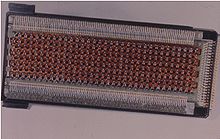- Core rope memory
-
Core rope memory is a form of read-only memory (ROM) for computers, first used by early NASA Mars probes and then in the Apollo Guidance Computer (AGC) designed and programmed by the MIT Instrumentation Lab and built by Raytheon.
Contrary to ordinary coincident-current magnetic core memory, which was used for RAM at the time, the ferrite cores in a core rope are just used as transformers. The signal from a word line wire passing through a given core is coupled to the bit line wire and interpreted as a binary "one" while a word line wire that bypasses the core is not coupled to the bit line wire and is read as a "zero". In the AGC, up to 64 wires could be passed through a single core.
Software written by MIT programmers was woven into core rope memory by female workers in factories. Some programmers nicknamed the finished product LOL memory, for Little Old Lady memory.[1]
Contents
Memory density
A relatively large (by the standards of the time) amount of data could be stored in a small installed volume of core rope memory (72 kilobytes per cubic foot; roughly 2.5 megabytes per cubic meter); about 18-folda the amount of data per volume compared to standard read-write core memory.
Memory
technologyData units per cubic foot Data units per cubic meter Bytes Bits Bytes Bits Core rope ROM 72 KB 576 Kbit ~2.5 MB ~20 Mbit Magnetic core RAM 4 KB 32 Kbit ~140 KB ~1 Mbit  Rope memory from the Apollo Guidance Computer
Rope memory from the Apollo Guidance Computer
Notes
- a^ The Block II Apollo Guidance Computer (AGC) used 36,864 sixteen-bit words of core rope memory (placed within one cubic foot) and 4,096 words of magnetic core memory (within two cubic feet). Other machines will have somewhat different ratios between the two memory types.
References
- ^ "The Navigation Computer". Directed and Produced by: Duncan Copp, Nick Davidson, Christopher Riley. Moon Machines. Science Channel. 2008-07-07. No. 3. 22:40 minutes in.
External links
- Visual Introduction to the Apollo Guidance Computer, part 3: Manufacturing the Apollo Guidance Computer. – By Raytheon; hosted by the Library of the California Institute of Technology's History of Recent Science & Technology site (originally hosted by the Dibner Institute)
- Computers in Spaceflight: The NASA Experience – By James Tomayko (Chapter 2, Part 5, "The Apollo guidance computer: Hardware")
Magnetic storage media Wire (1898) • Tape (1928) • Drum (1932) • Ferrite core (1949) • Hard disk (1956) • Stripe card (1956) • MICR (1956) • Thin film (1962) • CRAM (1962) • Twistor (~1968) • Floppy disk (1969) • Bubble (~1970) • MRAM (1995) • Racetrack (2008)

This computer hardware article is a stub. You can help Wikipedia by expanding it.

